#sydney muldoon
Text
alright KOllOK nation, who wants some sweet sweet fanfic?
https://archiveofourown.org/works/39347130
23 notes
·
View notes
Link
#spiders 3D#sci-fi#horror#tibor takács#christa campbell#patrick muldoon#sydney sweeney#trash#spiders#film#review#recensione#italian#italiano#mymadreams
0 notes
Text
From the Facebook page poor rank and file dot ca, June 11, 2021:
Today is Davis Day in Nova Scotia. William Davis was a coal miner shot and killed June 11 by company police during the 1925 Cape Breton coal miners' strike. The miners were fighting against a 20 percent wage cut imposed by the British Empire Steel and Coal Company (BESCO), the largest corporation in Canada at the time.
For several years before the 1925 strike, BESCO had been locked in a massive battle against the coal miners and against the Sydney steelworkers fighting for union recognition. BESCO routinely used police, the military and the courts to smash the workers' efforts. One of the leaders to emerge out of these struggles was the legendary JB McLachlan.
The 1925 strike started because BESCO was seeking a 20 percent wage reduction. This was followed up by BESCO cutting off all credit at the company stores to starve the miners and their families into submission. The miners responded with an "all-out" strike, meaning pumping operations would be shut down and the mines would flood.
Miners also controlled the New Waterford power plant and pumping station which kept water and power flowing to communities. On June 4, BESCO company police seized the power plant and cut off the power and water. On June 10, miners marched on the plant and convinced the company scabs to give up control.
Determined to punish the miners, a hundred company police attacked unarmed residents in New Waterford. They were soon confronted by an army of 3,000 miners. The company goons charged and opened fire, killing Davis, but were overwhelmed by the miners. The murderers, many of them beaten and bloodied, were thrown in the town jail only to be rescued by BESCO police the next day.
On June 14, 5,000 attended Davis's funeral and the union established a fund for Davis's wife and ten children.
At the request of the company, 2,000 troops were quickly dispatched from Halifax, placing Cape Breton under military occupation. It was the largest domestic military operation since the 1885 Northwest Rebellion. Militant miners were blacklisted, a ten percent wage cut imposed, and the powerful miners' union weakened massively.
The BESCO police officer who murdered Davis, Harry Muldoon, was quickly relocated to Boston with his family and he escaped justice. The Crown also dropped charges against Joseph MacLeod who was also charged for the murder.
The following year, June 11 1926, Davis Day began as coal miners refused to work and marched instead. It was not recognized as an official holiday until 1969.
"Under capitalism the working class has but two courses to follow: crawl or fight" - JB McLachlan

165 notes
·
View notes
Text
HOW TO RULE THE WORLD - a bRAyVE REVIEW by Cathy Bray
HOW TO RULE THE WORLD by Nakkiah Lui, Sydney Theatre Company, Drama Theatre, Sydney Opera House.
6.30pm 4th March, 2019
Playwright: Nakkiah Lui
Director: Paige Rattray
Designer: Marg Horwelll
Lighting & AV Designer: Emma Valente
Composer and Sound Designers: Paul Mac
Steve Francis
Production Manager: Kate Chapman
Stage Manager: Sarah Smith
Zaza: Michelle Lim Davidson
Male Ensemble: Gareth Davies
Female Ensemble: Vanessa Downing
Vic: Nakkiah Lui
Lewis Lewis/Tommy Ryan: Hamish Michael
Prime Minister: Rhys Muldoon
Chris: Anthony Taufa
SHE HAS A DREAM…
This is a rave review about Nakkiah Lui’s HOW TO RULE THE WORLD and the great Indigenous soliloquy for Australia contained therein.
This perfect political satire set in the ‘Canberra bubble’ is a cup flowing over with painful exposes of the hypocrisy of all those sucked into the vortex of political expediency. The first few acts are a joy to watch as we swim easily back and forwards, picking up the nuances thrown over the actors’ shoulders like bait from a fishing trawler.
And then right in the middle of this rollicking derision, up steps the playwright Nakkiah Lui. Not to share our joy or reassure us. No, not speaking as her character Vic. No. She’s come instead, centre stage and with attitude, as the author herself, to deliver one of the greatest monologues ever produced in the Australian theatre. Lui steps forward with studied confidence and proceeds to not just break the Fourth Wall but to actually kick it in the gonads. I’ve changed my mind, it was not just a monologue, it was an utterly direct and honest soliloquy which I will call without having actually read the script THE (NO) HOPE SOLILOQUY, a truth-telling from Lui about what it feels like in this day and age to be an Aboriginal woman who has suffered unforgiveable humiliation, insurmountable pain and the cauterising loss of close relatives and friends, to suicide.
End scene and the cut and her return as the character Vic, to the rest of this absurdist Canberra reality, makes the contrast between these two worlds even sharper. Lui’s writing is going from strength to strength. So enjoyable to see her sense of humour and satiric wit beaming throughout, enlightening us without any need for didactic dinner party diatribes. Through the soliloquy, Lui demanded our attention and our silence and she got it.
If that speech could be printed and distributed in schools, our children and grandchildren would have their very own ‘She has a dream’ speech to inspire the new, young way. Politicians, please get out of the way so that ordinary Australians can start listening to Nakkiah Lui and the generations of Aboriginal children and future collaborators who will join her.
2 notes
·
View notes
Text


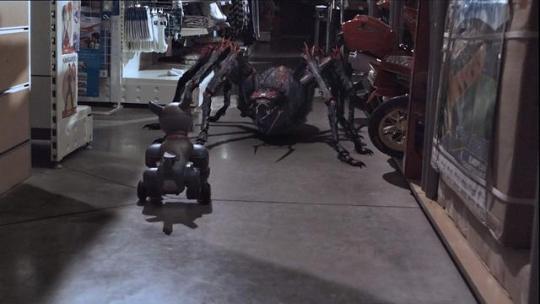
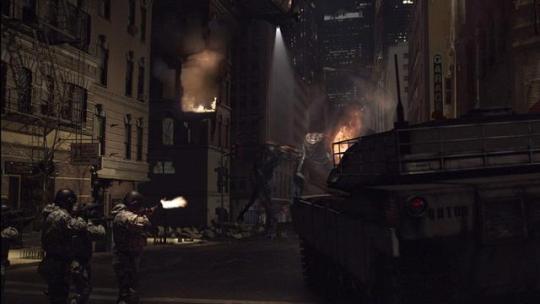
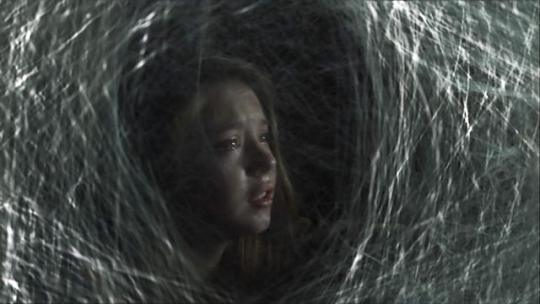





Spiders 3D (2011)
Dir. Tibor Takács
☆Patrick Muldoon, Christa Campbell, Sydney Sweeney☆
2 notes
·
View notes
Text
LUCY AND JOAN RIVERS DO JURY DUTY
S6;E9 ~ November 5, 1973


Directed by Coby Ruskin ~ Written by Bob Carroll Jr. and Madelyn Davis
Synopsis
Lucy is called to jury duty and clashes with one of her fellow jurors (Joan Rivers). After Lucy is the sole dissenter toward a unanimous verdict, the unlikely pair must room together for the night.
Regular Cast

Lucille Ball (Lucy Carter), Gale Gordon (Harrison Otis Carter)
Lucie Arnaz (Kim Carter) does not appear in this episode, nor is she mentioned in the dialogue. The final credits do state, however, “Lucie Arnaz wardrobe by Alroe.”
Guest Cast ~The Jury

1) Joan Rivers (Joan Reynolds, Juror) was born in 1933 as Joan Alexandra Molinksy. She became stand-up comedian, actress, writer, producer, and television host. She was noted for her often controversial comedic persona - heavily self-deprecating or sharply acerbic - especially toward celebrities and politicians. Rivers gained prominence in 1965 as a guest on “The Tonight Show.” Hosted by her mentor, Johnny Carson, the show established Rivers' comedic style. She also was the first female guest-host of the show interviewing Lucille Ball three times. She was nominated for a Tony on Broadway and co-wrote two plays. There seemed like nothing Rivers could not (or would not) do. She died in 2014.
Joan Reynolds' boyfriend is named Marvin Winterbottom III. Joan thinks he is about to 'pop the question.'

2) James E. Brodhead (Mr. Miller, Jury Foreman ) previously played Tilford in “The Big Game” (S6;E2). He makes his fourth screen appearance in a career that lasted until 1995.
3) Burt Mustin (Mr. Robertson, elderly juror) was born in 1884! He didn’t do his first film until age 67, although his stage and radio career started earlier. He was generally cast as the stereotypical little old man. He is probably best remembered as Mr. Quigley on “All in the Family” and Mr. Lanson on “Phyllis.” He played Old Uncle Joe in two 1973 episodes of “The Lucy Show.” Mustin also played Uncle Jeff in Mame (1974). He died at age 92.
Mr. Robertson has a date with a 'heavy date with a swinging chick' after the deliberations.
4) Judd Laurance (Mr. Stalkup, Football Fan Juror) started his screen career in 1969 doing mostly crime dramas. This is his only appearance with Lucille Ball.
Mr. Stalkup has tickets for a Rams game after the deliberations. His surname is never spoken aloud, only listed in the final credits.
5) Savannah Bentley (Miss Holmes, Juror) makes her only appearance with Lucille Ball.
Her surname is never spoken aloud, only listed in the final credits.
6) Alice Backes (Mrs. Barnes, Juror) made her first TV appearance as a contestant on Groucho Marx's “You Bet Your Life” in 1950, billed as a 'future actress.’ She previously appeared on the series in “Lucy, the Matchmaker” (S1;E12). By her death she accumulated nearly 100 screen credits, so her game show ambitions were more than realized.
Mrs. Barnes is celebrating her wedding anniversary.
7) Lew Palter (Mr. Patrick, Juror) holds a PhD in Theatre and has been a well respected acting instructor for decades. This is his only appearance with Lucille Ball.
Mr. Patrick's name is never spoken in the dialogue, it is just listed in the final credits.
8) Shirley Anthony (Juror) makes the seventh of her 13 episodes of “Here’s Lucy.” This is one of only two times where she received screen credit.
9) Bob Whitney (Juror) appeared with Lucille Ball in The Facts of Life (1960). This is the third of his five appearances on the series.
10) Sid Gould (Juror) made more than 45 appearances on “The Lucy Show,” all as background characters. This is one of his nearly 50 episodes of “Here’s Lucy.” Gould (born Sydney Greenfader) was Lucille Ball’s cousin by marriage to Gary Morton.
11) Walter Smith (Juror) made 14 mostly uncredited appearances on the series. He also did one episode of “The Lucy Show.”

Hank Brandt (Bailiff) was born in 1934 in New Jersey. He began his screen acting career in 1961. He previously played one of the astronauts in “Lucy and the Astronauts” (S4;E5) and Johnny Muldoon in “Lucy and the Little Old Lady” (S4;E17). This is his final episode of the series.
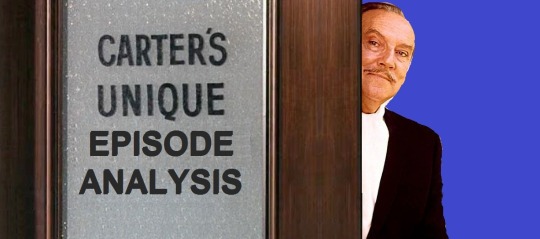

When Lucille Ball died in 1989, Joan Rivers wrote:
“She was tough, smart, a brilliant comedian and a walking master class in comedy.”

When Joan Rivers died in 2014, The Lucille Ball / Desi Arnaz Museum and Center for Comedy wrote a tribute to her on their website, remembering her visit in 2012:
“In an effort to showcase the very best in American comedy in Jamestown, Joan Rivers joined us to celebrate the 100th anniversary of Lucille Ball’s birth date in the most fitting way possible; laughter. Her presence has been a key factor in the realization of Lucille Ball’s wish for her hometown: to celebrate and honor the best in comedy. Like Lucy, Joan changed the face of comedy for women on TV. We will continue to celebrate Joan’s unique talents so that her legacy lives on for generations to come.”
~ Journey Gunderson, Executive Director
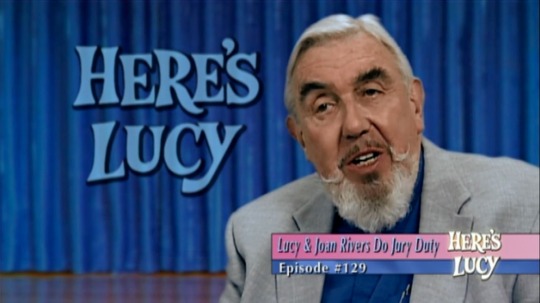
In his DVD introduction, James E. Brodhead (Jury Foreman) recalls that the episode was filmed in fall of 1973.

Brodhead also remembers that Lucy and Joan enjoyed making each other laugh.

As Johnny Carson’s substitute host on “The Tonight Show,” Joan Rivers interviewed Lucille Ball several times.
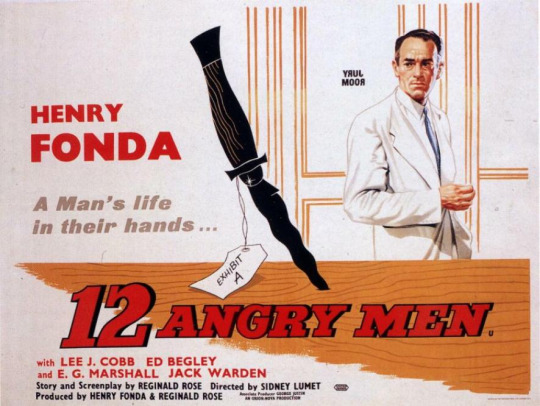
This episode is a loose satire of 12 Angry Men (1957), a film starring Henry Fonda about a lone juror standing up for his principles. The movie is mentioned by Joan Rivers in the dialogue. It was based on the CBS 1954 teleplay “Twelve Angry Men” which inspired a 1955 stage play. On television, the lone hold out was played by “Lucy” alumni Bob Cummings. Henry Fonda co-starred with Ball in the 1968 film Yours, Mine and Ours.

The case is about the last will and testament of one Everett Covington, who has left his million dollar fortune to his nurse, Susan Bartlett. The will is contested by Covington's grandson, George, on the basis that his grandfather was coerced by the much-younger Bartlett to change his will.

Lucy calls elderly juror Mr. Robertson “the Burt Reynolds of Sun City.” The actor (and Playgirl centerfold) Burt Reynolds was one of the hottest male sex symbols of the 1970s. He released three films in 1973 alone. Sun City is a gated, age-restricted community outside of Palm Springs, California. In 2008 it was renamed Desert Springs.

Harry picks up Lucy a couple of magazines to read in her hotel room confinement: Fisherman's Quarterly and The TV Log, two fictional publications.


This is the third celebrity named Joan that has guest-starred with Lucille Ball. The other two are Joan Blondell...

and Joan Crawford.

Although they can't talk about the case, Lucy reasons they can act it out through charades. This gives Lucille Ball a chance to do pantomime, something she loved and was quite good at.

Lucy first played charades on TV in “The Gossip” (ILL S1;E24) in 1952.

The argument between Lucy and Joan about whether to sleep with the window open or closed was also a point of contention between Lucy and Ricky Ricardo in “Breaking the Lease” (ILL S1;E18).

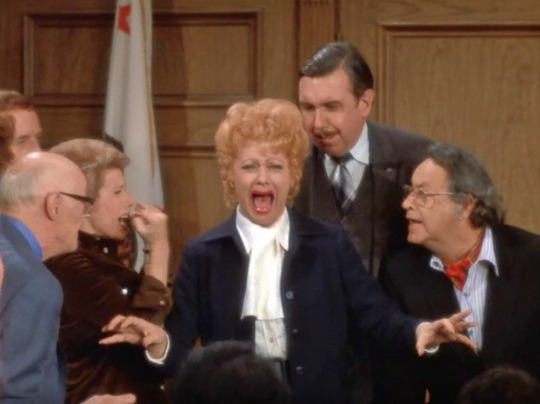
Sitcom Logic Alert! A contested will would certainly not call for a jury trial lasting two weeks.

“Lucy and Joan Rivers Do Jury Duty” rates 3 Paper Hearts out of 5
It is good to see Rivers in an acting role and riffing with the great Lucille Ball. Lucy was very supportive of women in comedy, although she and Rivers were very different. For all its silly improbability, it is a watchable episode.

#Here's Lucy#Lucille Ball#Gale Gordon#Joan Rivers#Sid Gould#Coby Ruskin#Madelyn Davis#Bob Carroll Jr.#James E. Brodhead#Burt Mustin#Judd Laurance#Savannah Bentley#Alice Backes#Lew Palter#Shirley Anthony#Bob Whitney#Walter Smith#Hank Brandt#12 Angry Men#Twelve Angry Men#Henry Fonda#jury#trial#Sun City#burt reynolds#charades#The Tonight Show#CBS#1973#TV
3 notes
·
View notes
Text
27th January 2020 Writings
27th
Excerpt from: The Engineer and the Time Lady
“Well, we don't.”
“Your ship looks rather stuck,” Nina pointed out.
“We are in trouble,” another crewmember admitted.
“Danoal!” the first crewmember chastised.
“If she wants to help...”
“No we can repair and relaunch the ship ourselves.”
Words: 37
Excerpt from: The Chronicles of Time: The Danae Error
“You’ll go back to the Titanic. I was there, so she’ll be there.”
“The Titanic?” Jess asked. “That makes no sense.”
Words: 21
Excerpt from: Age of Heroes v2
January 7, 1976
In New Zealand, Prime Minister Robert Muldoon receives a report on the Meteor Shower.
January 13, 1976
There is another report of a 'super' rescuing a person from a burning building in San Francisco.
January 14, 1976
Brezhnev receives a report that meteors had fallen in all 15 SSRs...
January 16, 1976
In a statement to the BBC, Wilson reveals that there had been reports of meteors in every county in the United Kingdom.
February 29, 1976
The 12 year old who had the precognitive vision two weeks before runs away from home.
March 2, 1976
Vanderbilt decides to cooperate with the police when it comes to fighting crime.
March 3, 1976
Vanderbilt discovers that she can also phase others through walls (as long as she's holding onto them).
March 4, 1976
Vanderbilt takes the alias of 'Phase Lady'.
March 5, 1976
Some meteoric material washes up on Coogee Beach (to the south of Bondi), Sydney...
March 6, 1976
A second meteor is found of the grounds of the University of New England (in the duck pond near Mary White College...)
March 7, 1976
A second meteor is found in the Warrumbungles ranges, near the Grand High Tops.
March 8, 1976
In a report delivered to Muldoon, there are over 1000 reported metahumans in New Zealand.
April 11, 1976
Some meteoric material washes up on Cronulla beach (southern Sydney)...
February 27, 1976
On a Concorde headed to Paris, a teenager suddenly freaks out, as her vision-related powers activate...
August 11, 1977
First appearance in Coffs Harbour of LaserEyes...
June 10, 1981
In Canberra, the Capital Territory Academy for Supers is established. This is the first Australian academy for Teen Metahumans.
June 11, 1981
Singer Ringo Starr announces his support for metahumans.
August 10, 1981
In Canberra, Prime Minister Malcolm Fraser announces the formation of an agency for the monitoring of provision of assistance to metahumans.
September 10, 1981
Lennon releases a new song. Meta Love Story.
October 11, 1981
Astrid Stien begins calling Police ahead of time to have people caught in the act...
August 5, 2002
“I know,” Ar-TK said. “But we could go around Armidale tonight, and talk while we do it.”
“That's a good idea,” Led-audir considered.
“So, you have any special equipment we'll need before we go down-town?”
“Not much, just a bike. But we don't need it tonight.”
“Let's go then.”
Half an hour later, the two metas left the University grounds to the southeast, turning the corner from Elm Avenue into Queen Elizabeth Drive. “Where first?” Ar-TK asked.
“We'll circle Girraween first,” Led-audir answered, referring to a public housing estate between the University and the older parts of Armidale.
“Sure.”
The two metas soon came to the overpass, where Queen Elizabeth Drive crossed over the New England Highway. “This is a good spot,” AR-TK said.
“Huh?” Led-audir asked.
“We can talk about our abilities,” she paused. “If you want to, that is.”
“Um, sure,” Led-audir said, sounding a little nervous. “We can.” He put his hands on the railings. “It can't really be demonstrated. I focus and then I can use it to sense.”
“There is a way,” AR-TK interjected.
“Oh?”
“Telekinesis is merely my primary power.”
“So, you're a telepath too?” Led-audir guessed.
She nodded. “Yes, but quite weak. It only works via touch. I would receive what you're sensing, sight, hearing, touch, your ability, and your surface thoughts, nothing more,” she added in a reassuring way.
Words: 577
Total: 635
0 notes
Text
The Most Important Cocktail Bars of the Decade (2010s)
With last orders set to be called not only on the year, but on an entire decade, there’s barely enough time to pause and reflect. But in reviewing the past 10 years and pondering the most important shifts in drinking culture, we identified the most influential trends, and the bars that best encapsulated them.
What exactly do we mean by influential? These are the spots that pushed boundaries, ushered in an era of new “norms,” and captured the zeitgeist of the decade. Some of them were notable as a timestamp for the 2010s, while others paved an import path for years (and possibly decades) to come.
You might notice some trends and bars missing from this list that have been prominent in the last decade. These include the revival of the hotel bar (The Connaught), the modernization of tiki (Smuggler’s Cove), and the proliferation of speakeasies (Milk & Honey, PDT). None are featured here as each of those bars opened before the beginning of 2010 and the trends were already in motion at the beginning of the decade.
Here is VinePair’s list of the five most influential cocktail bars of the last 10 years and how they defined the decade in drinks.
The Aviary champions avant-garde cocktails and molecular techniques.
When Grant Achatz, one of the country’s most celebrated, innovative chefs, opened Chicago’s revolutionary Aviary bar in 2011, his first rebellious act was to remove the bar entirely. It was a bold, left-field move, but just one of a number of ways in which the Aviary reinvented the traditional cocktail bar.
Drinks from the Aviary’s range of tasting menus are prepared inside the bar’s kitchen, where a group of “cooks,” led by a “chef,” work wizardry behind a large metal cage. Their mysterious creations are then delivered to patrons in 30-or-so different custom-made vessels. Many are finished table-side and some arrive with aroma-filled plastic bags to enhance the experience.
The Aviary’s ice program is similarly innovative. In a sprawling basement beneath the bar, dedicated ice chefs create 39 different forms of frozen H2O. Some will be used as serving vessels, and others are infused with substances that add to a drink’s flavor, rather than dilute it as they melt.
Since its 2011 launch, the Aviary has scooped up dozens of high-profile awards, including “World’s Best Cocktail Menu,” awarded by the Tales of the Cocktail Foundation in 2014. The bar launched a second location in New York in September 2018. Situated on the 35th floor of the Mandarin Oriental Hotel, the bar enjoys a birds-eye view of the city’s Central Park.
The Aviary’s much-anticipated cocktail book followed in October of the same year. Four years in the making, it mapped multiple iterations of each of its legendary drinks. Recipes change depending on whether the cocktail is being made for a single recipe or a batch, with different variations for professional bars and adaptations for (daring) home cocktail enthusiasts.
The Aviary was, and continues to be, influential not for spawning an army of imitators, but for introducing ideals and techniques that would be adopted and adapted by some of the decade’s highest-profile bars. With paired food and cocktail tasting menus, and the transformation of Lewis Carroll-esque fiction into imbibable reality, the Aviary did not say, “This is how it’s done,” but instead showed what could be done.
Notable bars that exemplified/furthered the trend: Artesian (London, England); Booker and Dax (New York, NY [CLOSED]); Columbia Room (Washington, DC); Existing Conditions (New York, NY)
The Dead Rabbit introduces world-class cocktails to the (relative) masses.
New York’s 22-square-mile Manhattan island boasts more than 120 Irish bars, though none of them are quite like The Dead Rabbit. Launched by Belfast natives Sean Muldoon and Jack McGarry in 2013, The Dead Rabbit is split over three levels, with a 2019 expansion doubling its overall size.
In the downstairs Taproom, traditional Irish hospitality is recreated in the form of a sawdust-littered floor, warming (read: boozy) Irish punch, and the bar’s now-famous Irish coffee. The Guinness is as good as it gets this side of the pond, and the bar’s 145-strong Irish whiskey collection is the largest in North America. (Dead Rabbit even launched its own Irish whiskey in 2018.)
But this bar is about more than comforting hospitality. Climb the stairs to its Parlor bar, and you’ll see why The Dead Rabbit topped the list of The World’s 50 Best Bars in 2016. Bar manager Jillian Vose oversees a vast cocktail program that’s presented in an illustrated graphic novel. Categorized into shades, the drinks start light (a reference to their alcohol content) then get progressively stronger as the menu proceeds. No matter the shade, each is a triumphant execution of harmony and in-depth understanding of their ingredients.
The Dead Rabbit launched at a time when New York’s best cocktails were almost exclusively consigned to dimly lit, limited- capacity venues. In the seven years since, it’s proved that world-class drinks can be found anywhere; perhaps where you least expect them, like a traditional-looking Irish bar that pours exceptional Guinness. If the craft cocktail renaissance of the early aughts rediscovered classic concoctions, and elevated the act of imbibing cocktails to its former heyday, The Dead Rabbit has succeeded in serving those ideals to the (relative) masses.
Notable bars that exemplified/furthered the trend: Canon (Seattle, WA); Herbs & Rye (Las Vegas, NV); La Factoria (San Juan, Puerto Rico); Polite Provisions (San Diego, CA); Trick Dog (San Francisco, CA)
Dante becomes the epicenter of international aperitivo culture.
Caffe Dante first opened its doors on New York’s Macdougal Street in 1915. A century later, a trio of Australians took over the space and transformed the fading Italian café into one of the world’s leading cocktail bars.
The renovations were respectful of the café’s past, maintaining its layout and façade, but upgraded its interior to a bright, white-tiled space befitting of the modern-day surrounding Greenwich Village neighborhood. The drinks showcased Italy’s greatest contributions to international cocktail culture, with a much-lauded, revamped Garibaldi and dedicated Negroni and Spritz menus, with dozens of riffs on the classics. (The bar even serves Negronis on draft.)
At the time of reopening, the notion that three Australians would school New Yorkers on Italian aperitivo culture seemed unlikely. But succeed they did, and on a staggering international level. Naren Young, the best known of the trio, has since helmed Dante pop-ups in numerous cities worldwide, including Barcelona, London, Moscow, Sydney, and, most recently, Vancouver. The jewel in the bar’s crown arrived in 2019, when Dante was awarded the No. 1 spot on the list of The World’s 50 Best Bars.
With its dedication to spreading aperitivo culture and reputation for serving some of the finest iterations of the Negroni worldwide (not to mention its Spritzes), Dante captured the cocktail zeitgeist of the 2010s. Its outdoor terrace and open-plan salon serve as further proof that exclusivity is no longer a prerequisite for world-class cocktail bars.
Notable bars that exemplified/furthered the trend: Bar Termini (London, England); Born & Raised (San Diego, CA)
‘Lyan’ bars place sustainability front and center.
On many counts, London’s Ryan Chetiyawardana is one of the most forward-thinking, influential bartenders of the decade. Better known as Mr. Lyan, in 2013 Chetiyawardana opened White Lyan in London’s trendy Hoxton neighborhood. There, he adopted various practices that were pioneering at the time, but have worked their way into the mainstream seven years on.
Chetiyawardana commissioned his own spirits; pre-batched cocktails to cut down on wait times; sold takeaway, bottled versions of those drinks; and — most importantly — placed sustainability front and center at the bar, eliminating waste by doing away with perishables such as citrus and ice (the latter aided by the fact that the pre-batched cocktails could be chilled in fridges and freezers before service).
Chetiyawardana and the bar’s co-owner, Ian Griffiths, shut the doors at White Lyan in 2016, transforming the spot into a creative development space. By this time, they had already opened a second bar, Dandelyan, in a hotel on the South Bank of London’s River Thames. Dandelyan went on to win Tales of the Cocktail’s World’s Best Cocktail Menu in 2016 and 2018, and also topped the list of The World’s 50 Best Bars in 2018 — just two days after the duo had announced the bar was to shut. Various high-profile international pop-ups have followed and the team currently runs two permanent locations (for now): Lyaness, in London, and Super Lyan in Amsterdam.
That Chetiyawardana has operated on the highest level for the best part of a decade is notable enough. Doing so while championing “closed-loop” sustainable practices, many of which have been adopted by other high-profile establishments, leaves an important, enduring legacy. It’s one that should shape the future cocktail landscape for years if not decades to come.
Notable bars that exemplified/furthered the trend: HIMKOK (Oslo, Norway); Native (Singapore); Charlie Parker’s (Sydney, Australia)
Miracle creates a globally successful pop-up trend.
If you’ve visited any notable New York cocktail bar in the past decade, chances are it’s been influenced or owned by Greg Boehm. Boehm has stakes in some of the city’s finest drinking destinations, including Boilermaker, Mace, Existing Conditions, and Katana Kitten. If you haven’t been to those bars, the bartenders at the spots you have visited were almost certainly using Boehm’s industry-standard cocktail equipment, which he sells through the drinkware company Cocktail Kingdom.
But perhaps Boehm’s most impactful influence on the decade’s cocktail scene — certainly from a global perspective — is the Miracle Christmas pop-up franchise that debuted in 2014.
With construction flagging on his upcoming East Village cocktail bar, Boehm temporarily transformed the unfinished space into a themed pop-up serving holiday-inspired drinks. Crowds flocked to the bar, queuing in the freezing New York winter, for a sip of festive cheer among its kitschy Christmas décor.
When bar industry friends asked if they could recreate the experience the following year, Miracle expanded to four locations. In 2016, the franchise went global, with pop-ups in Greece, Montreal, and Paris. In 2019, Miracle is set to feature more than 100 global outposts, reaching such destinations as Panama, Romania, New Zealand, and Switzerland.
While never intended as a “serious” bar, nor a recurring feature, the incredible, rapid expansion of this pop-up is nothing short of a miracle (sorry!). With its huge social media appeal and the proliferation of pop-ups since, this trend looks set to continue well into the next decade. The fact that drinkers around the world, from Bentonville, AR, to Bucharest, Romania, are right now united through their shared festive libations, is a worthy source of Christmas cheer and warming thought to close the decade.
Notable bars that exemplified/furthered the trend: Broken Shaker (Started as a pop-up in Miami, FL; now has permanent locations in Chicago, IL; Los Angeles, CA; Miami, FL; and New York, NY, and has hosted international pop-ups.)
The article The Most Important Cocktail Bars of the Decade (2010s) appeared first on VinePair.
source https://vinepair.com/articles/list-best-bars-world-2010s/
source https://vinology1.tumblr.com/post/189704808074
0 notes
Text
The Most Important Cocktail Bars of the Decade (2010s)
With last orders set to be called not only on the year, but on an entire decade, there’s barely enough time to pause and reflect. But in reviewing the past 10 years and pondering the most important shifts in drinking culture, we identified the most influential trends, and the bars that best encapsulated them.
What exactly do we mean by influential? These are the spots that pushed boundaries, ushered in an era of new “norms,” and captured the zeitgeist of the decade. Some of them were notable as a timestamp for the 2010s, while others paved an import path for years (and possibly decades) to come.
You might notice some trends and bars missing from this list that have been prominent in the last decade. These include the revival of the hotel bar (The Connaught), the modernization of tiki (Smuggler’s Cove), and the proliferation of speakeasies (Milk & Honey, PDT). None are featured here as each of those bars opened before the beginning of 2010 and the trends were already in motion at the beginning of the decade.
Here is VinePair’s list of the five most influential cocktail bars of the last 10 years and how they defined the decade in drinks.
The Aviary champions avant-garde cocktails and molecular techniques.
When Grant Achatz, one of the country’s most celebrated, innovative chefs, opened Chicago’s revolutionary Aviary bar in 2011, his first rebellious act was to remove the bar entirely. It was a bold, left-field move, but just one of a number of ways in which the Aviary reinvented the traditional cocktail bar.
Drinks from the Aviary’s range of tasting menus are prepared inside the bar’s kitchen, where a group of “cooks,” led by a “chef,” work wizardry behind a large metal cage. Their mysterious creations are then delivered to patrons in 30-or-so different custom-made vessels. Many are finished table-side and some arrive with aroma-filled plastic bags to enhance the experience.
The Aviary’s ice program is similarly innovative. In a sprawling basement beneath the bar, dedicated ice chefs create 39 different forms of frozen H2O. Some will be used as serving vessels, and others are infused with substances that add to a drink’s flavor, rather than dilute it as they melt.
Since its 2011 launch, the Aviary has scooped up dozens of high-profile awards, including “World’s Best Cocktail Menu,” awarded by the Tales of the Cocktail Foundation in 2014. The bar launched a second location in New York in September 2018. Situated on the 35th floor of the Mandarin Oriental Hotel, the bar enjoys a birds-eye view of the city’s Central Park.
The Aviary’s much-anticipated cocktail book followed in October of the same year. Four years in the making, it mapped multiple iterations of each of its legendary drinks. Recipes change depending on whether the cocktail is being made for a single recipe or a batch, with different variations for professional bars and adaptations for (daring) home cocktail enthusiasts.
The Aviary was, and continues to be, influential not for spawning an army of imitators, but for introducing ideals and techniques that would be adopted and adapted by some of the decade’s highest-profile bars. With paired food and cocktail tasting menus, and the transformation of Lewis Carroll-esque fiction into imbibable reality, the Aviary did not say, “This is how it’s done,” but instead showed what could be done.
Notable bars that exemplified/furthered the trend: Artesian (London, England); Booker and Dax (New York, NY [CLOSED]); Columbia Room (Washington, DC); Existing Conditions (New York, NY)
The Dead Rabbit introduces world-class cocktails to the (relative) masses.
New York’s 22-square-mile Manhattan island boasts more than 120 Irish bars, though none of them are quite like The Dead Rabbit. Launched by Belfast natives Sean Muldoon and Jack McGarry in 2013, The Dead Rabbit is split over three levels, with a 2019 expansion doubling its overall size.
In the downstairs Taproom, traditional Irish hospitality is recreated in the form of a sawdust-littered floor, warming (read: boozy) Irish punch, and the bar’s now-famous Irish coffee. The Guinness is as good as it gets this side of the pond, and the bar’s 145-strong Irish whiskey collection is the largest in North America. (Dead Rabbit even launched its own Irish whiskey in 2018.)
But this bar is about more than comforting hospitality. Climb the stairs to its Parlor bar, and you’ll see why The Dead Rabbit topped the list of The World’s 50 Best Bars in 2016. Bar manager Jillian Vose oversees a vast cocktail program that’s presented in an illustrated graphic novel. Categorized into shades, the drinks start light (a reference to their alcohol content) then get progressively stronger as the menu proceeds. No matter the shade, each is a triumphant execution of harmony and in-depth understanding of their ingredients.
The Dead Rabbit launched at a time when New York’s best cocktails were almost exclusively consigned to dimly lit, limited- capacity venues. In the seven years since, it’s proved that world-class drinks can be found anywhere; perhaps where you least expect them, like a traditional-looking Irish bar that pours exceptional Guinness. If the craft cocktail renaissance of the early aughts rediscovered classic concoctions, and elevated the act of imbibing cocktails to its former heyday, The Dead Rabbit has succeeded in serving those ideals to the (relative) masses.
Notable bars that exemplified/furthered the trend: Canon (Seattle, WA); Herbs & Rye (Las Vegas, NV); La Factoria (San Juan, Puerto Rico); Polite Provisions (San Diego, CA); Trick Dog (San Francisco, CA)
Dante becomes the epicenter of international aperitivo culture.
Caffe Dante first opened its doors on New York’s Macdougal Street in 1915. A century later, a trio of Australians took over the space and transformed the fading Italian café into one of the world’s leading cocktail bars.
The renovations were respectful of the café’s past, maintaining its layout and façade, but upgraded its interior to a bright, white-tiled space befitting of the modern-day surrounding Greenwich Village neighborhood. The drinks showcased Italy’s greatest contributions to international cocktail culture, with a much-lauded, revamped Garibaldi and dedicated Negroni and Spritz menus, with dozens of riffs on the classics. (The bar even serves Negronis on draft.)
At the time of reopening, the notion that three Australians would school New Yorkers on Italian aperitivo culture seemed unlikely. But succeed they did, and on a staggering international level. Naren Young, the best known of the trio, has since helmed Dante pop-ups in numerous cities worldwide, including Barcelona, London, Moscow, Sydney, and, most recently, Vancouver. The jewel in the bar’s crown arrived in 2019, when Dante was awarded the No. 1 spot on the list of The World’s 50 Best Bars.
With its dedication to spreading aperitivo culture and reputation for serving some of the finest iterations of the Negroni worldwide (not to mention its Spritzes), Dante captured the cocktail zeitgeist of the 2010s. Its outdoor terrace and open-plan salon serve as further proof that exclusivity is no longer a prerequisite for world-class cocktail bars.
Notable bars that exemplified/furthered the trend: Bar Termini (London, England); Born & Raised (San Diego, CA)
‘Lyan’ bars place sustainability front and center.
On many counts, London’s Ryan Chetiyawardana is one of the most forward-thinking, influential bartenders of the decade. Better known as Mr. Lyan, in 2013 Chetiyawardana opened White Lyan in London’s trendy Hoxton neighborhood. There, he adopted various practices that were pioneering at the time, but have worked their way into the mainstream seven years on.
Chetiyawardana commissioned his own spirits; pre-batched cocktails to cut down on wait times; sold takeaway, bottled versions of those drinks; and — most importantly — placed sustainability front and center at the bar, eliminating waste by doing away with perishables such as citrus and ice (the latter aided by the fact that the pre-batched cocktails could be chilled in fridges and freezers before service).
Chetiyawardana and the bar’s co-owner, Ian Griffiths, shut the doors at White Lyan in 2016, transforming the spot into a creative development space. By this time, they had already opened a second bar, Dandelyan, in a hotel on the South Bank of London’s River Thames. Dandelyan went on to win Tales of the Cocktail’s World’s Best Cocktail Menu in 2016 and 2018, and also topped the list of The World’s 50 Best Bars in 2018 — just two days after the duo had announced the bar was to shut. Various high-profile international pop-ups have followed and the team currently runs two permanent locations (for now): Lyaness, in London, and Super Lyan in Amsterdam.
That Chetiyawardana has operated on the highest level for the best part of a decade is notable enough. Doing so while championing “closed-loop” sustainable practices, many of which have been adopted by other high-profile establishments, leaves an important, enduring legacy. It’s one that should shape the future cocktail landscape for years if not decades to come.
Notable bars that exemplified/furthered the trend: HIMKOK (Oslo, Norway); Native (Singapore); Charlie Parker’s (Sydney, Australia)
Miracle creates a globally successful pop-up trend.
If you’ve visited any notable New York cocktail bar in the past decade, chances are it’s been influenced or owned by Greg Boehm. Boehm has stakes in some of the city’s finest drinking destinations, including Boilermaker, Mace, Existing Conditions, and Katana Kitten. If you haven’t been to those bars, the bartenders at the spots you have visited were almost certainly using Boehm’s industry-standard cocktail equipment, which he sells through the drinkware company Cocktail Kingdom.
But perhaps Boehm’s most impactful influence on the decade’s cocktail scene — certainly from a global perspective — is the Miracle Christmas pop-up franchise that debuted in 2014.
With construction flagging on his upcoming East Village cocktail bar, Boehm temporarily transformed the unfinished space into a themed pop-up serving holiday-inspired drinks. Crowds flocked to the bar, queuing in the freezing New York winter, for a sip of festive cheer among its kitschy Christmas décor.
When bar industry friends asked if they could recreate the experience the following year, Miracle expanded to four locations. In 2016, the franchise went global, with pop-ups in Greece, Montreal, and Paris. In 2019, Miracle is set to feature more than 100 global outposts, reaching such destinations as Panama, Romania, New Zealand, and Switzerland.
While never intended as a “serious” bar, nor a recurring feature, the incredible, rapid expansion of this pop-up is nothing short of a miracle (sorry!). With its huge social media appeal and the proliferation of pop-ups since, this trend looks set to continue well into the next decade. The fact that drinkers around the world, from Bentonville, AR, to Bucharest, Romania, are right now united through their shared festive libations, is a worthy source of Christmas cheer and warming thought to close the decade.
Notable bars that exemplified/furthered the trend: Broken Shaker (Started as a pop-up in Miami, FL; now has permanent locations in Chicago, IL; Los Angeles, CA; Miami, FL; and New York, NY, and has hosted international pop-ups.)
The article The Most Important Cocktail Bars of the Decade (2010s) appeared first on VinePair.
Via https://vinepair.com/articles/list-best-bars-world-2010s/
source https://vinology1.weebly.com/blog/the-most-important-cocktail-bars-of-the-decade-2010s
0 notes
Text
The Most Important Cocktail Bars of the Decade (2010s)
With last orders set to be called not only on the year, but on an entire decade, there’s barely enough time to pause and reflect. But in reviewing the past 10 years and pondering the most important shifts in drinking culture, we identified the most influential trends, and the bars that best encapsulated them.
What exactly do we mean by influential? These are the spots that pushed boundaries, ushered in an era of new “norms,” and captured the zeitgeist of the decade. Some of them were notable as a timestamp for the 2010s, while others paved an import path for years (and possibly decades) to come.
You might notice some trends and bars missing from this list that have been prominent in the last decade. These include the revival of the hotel bar (The Connaught), the modernization of tiki (Smuggler’s Cove), and the proliferation of speakeasies (Milk & Honey, PDT). None are featured here as each of those bars opened before the beginning of 2010 and the trends were already in motion at the beginning of the decade.
Here is VinePair’s list of the five most influential cocktail bars of the last 10 years and how they defined the decade in drinks.
The Aviary champions avant-garde cocktails and molecular techniques.
When Grant Achatz, one of the country’s most celebrated, innovative chefs, opened Chicago’s revolutionary Aviary bar in 2011, his first rebellious act was to remove the bar entirely. It was a bold, left-field move, but just one of a number of ways in which the Aviary reinvented the traditional cocktail bar.
Drinks from the Aviary’s range of tasting menus are prepared inside the bar’s kitchen, where a group of “cooks,” led by a “chef,” work wizardry behind a large metal cage. Their mysterious creations are then delivered to patrons in 30-or-so different custom-made vessels. Many are finished table-side and some arrive with aroma-filled plastic bags to enhance the experience.
The Aviary’s ice program is similarly innovative. In a sprawling basement beneath the bar, dedicated ice chefs create 39 different forms of frozen H2O. Some will be used as serving vessels, and others are infused with substances that add to a drink’s flavor, rather than dilute it as they melt.
Since its 2011 launch, the Aviary has scooped up dozens of high-profile awards, including “World’s Best Cocktail Menu,” awarded by the Tales of the Cocktail Foundation in 2014. The bar launched a second location in New York in September 2018. Situated on the 35th floor of the Mandarin Oriental Hotel, the bar enjoys a birds-eye view of the city’s Central Park.
The Aviary’s much-anticipated cocktail book followed in October of the same year. Four years in the making, it mapped multiple iterations of each of its legendary drinks. Recipes change depending on whether the cocktail is being made for a single recipe or a batch, with different variations for professional bars and adaptations for (daring) home cocktail enthusiasts.
The Aviary was, and continues to be, influential not for spawning an army of imitators, but for introducing ideals and techniques that would be adopted and adapted by some of the decade’s highest-profile bars. With paired food and cocktail tasting menus, and the transformation of Lewis Carroll-esque fiction into imbibable reality, the Aviary did not say, “This is how it’s done,” but instead showed what could be done.
Notable bars that exemplified/furthered the trend: Artesian (London, England); Booker and Dax (New York, NY [CLOSED]); Columbia Room (Washington, DC); Existing Conditions (New York, NY)
The Dead Rabbit introduces world-class cocktails to the (relative) masses.
New York’s 22-square-mile Manhattan island boasts more than 120 Irish bars, though none of them are quite like The Dead Rabbit. Launched by Belfast natives Sean Muldoon and Jack McGarry in 2013, The Dead Rabbit is split over three levels, with a 2019 expansion doubling its overall size.
In the downstairs Taproom, traditional Irish hospitality is recreated in the form of a sawdust-littered floor, warming (read: boozy) Irish punch, and the bar’s now-famous Irish coffee. The Guinness is as good as it gets this side of the pond, and the bar’s 145-strong Irish whiskey collection is the largest in North America. (Dead Rabbit even launched its own Irish whiskey in 2018.)
But this bar is about more than comforting hospitality. Climb the stairs to its Parlor bar, and you’ll see why The Dead Rabbit topped the list of The World’s 50 Best Bars in 2016. Bar manager Jillian Vose oversees a vast cocktail program that’s presented in an illustrated graphic novel. Categorized into shades, the drinks start light (a reference to their alcohol content) then get progressively stronger as the menu proceeds. No matter the shade, each is a triumphant execution of harmony and in-depth understanding of their ingredients.
The Dead Rabbit launched at a time when New York’s best cocktails were almost exclusively consigned to dimly lit, limited- capacity venues. In the seven years since, it’s proved that world-class drinks can be found anywhere; perhaps where you least expect them, like a traditional-looking Irish bar that pours exceptional Guinness. If the craft cocktail renaissance of the early aughts rediscovered classic concoctions, and elevated the act of imbibing cocktails to its former heyday, The Dead Rabbit has succeeded in serving those ideals to the (relative) masses.
Notable bars that exemplified/furthered the trend: Canon (Seattle, WA); Herbs & Rye (Las Vegas, NV); La Factoria (San Juan, Puerto Rico); Polite Provisions (San Diego, CA); Trick Dog (San Francisco, CA)
Dante becomes the epicenter of international aperitivo culture.
Caffe Dante first opened its doors on New York’s Macdougal Street in 1915. A century later, a trio of Australians took over the space and transformed the fading Italian café into one of the world’s leading cocktail bars.
The renovations were respectful of the café’s past, maintaining its layout and façade, but upgraded its interior to a bright, white-tiled space befitting of the modern-day surrounding Greenwich Village neighborhood. The drinks showcased Italy’s greatest contributions to international cocktail culture, with a much-lauded, revamped Garibaldi and dedicated Negroni and Spritz menus, with dozens of riffs on the classics. (The bar even serves Negronis on draft.)
At the time of reopening, the notion that three Australians would school New Yorkers on Italian aperitivo culture seemed unlikely. But succeed they did, and on a staggering international level. Naren Young, the best known of the trio, has since helmed Dante pop-ups in numerous cities worldwide, including Barcelona, London, Moscow, Sydney, and, most recently, Vancouver. The jewel in the bar’s crown arrived in 2019, when Dante was awarded the No. 1 spot on the list of The World’s 50 Best Bars.
With its dedication to spreading aperitivo culture and reputation for serving some of the finest iterations of the Negroni worldwide (not to mention its Spritzes), Dante captured the cocktail zeitgeist of the 2010s. Its outdoor terrace and open-plan salon serve as further proof that exclusivity is no longer a prerequisite for world-class cocktail bars.
Notable bars that exemplified/furthered the trend: Bar Termini (London, England); Born & Raised (San Diego, CA)
‘Lyan’ bars place sustainability front and center.
On many counts, London’s Ryan Chetiyawardana is one of the most forward-thinking, influential bartenders of the decade. Better known as Mr. Lyan, in 2013 Chetiyawardana opened White Lyan in London’s trendy Hoxton neighborhood. There, he adopted various practices that were pioneering at the time, but have worked their way into the mainstream seven years on.
Chetiyawardana commissioned his own spirits; pre-batched cocktails to cut down on wait times; sold takeaway, bottled versions of those drinks; and — most importantly — placed sustainability front and center at the bar, eliminating waste by doing away with perishables such as citrus and ice (the latter aided by the fact that the pre-batched cocktails could be chilled in fridges and freezers before service).
Chetiyawardana and the bar’s co-owner, Ian Griffiths, shut the doors at White Lyan in 2016, transforming the spot into a creative development space. By this time, they had already opened a second bar, Dandelyan, in a hotel on the South Bank of London’s River Thames. Dandelyan went on to win Tales of the Cocktail’s World’s Best Cocktail Menu in 2016 and 2018, and also topped the list of The World’s 50 Best Bars in 2018 — just two days after the duo had announced the bar was to shut. Various high-profile international pop-ups have followed and the team currently runs two permanent locations (for now): Lyaness, in London, and Super Lyan in Amsterdam.
That Chetiyawardana has operated on the highest level for the best part of a decade is notable enough. Doing so while championing “closed-loop” sustainable practices, many of which have been adopted by other high-profile establishments, leaves an important, enduring legacy. It’s one that should shape the future cocktail landscape for years if not decades to come.
Notable bars that exemplified/furthered the trend: HIMKOK (Oslo, Norway); Native (Singapore); Charlie Parker’s (Sydney, Australia)
Miracle creates a globally successful pop-up trend.
If you’ve visited any notable New York cocktail bar in the past decade, chances are it’s been influenced or owned by Greg Boehm. Boehm has stakes in some of the city’s finest drinking destinations, including Boilermaker, Mace, Existing Conditions, and Katana Kitten. If you haven’t been to those bars, the bartenders at the spots you have visited were almost certainly using Boehm’s industry-standard cocktail equipment, which he sells through the drinkware company Cocktail Kingdom.
But perhaps Boehm’s most impactful influence on the decade’s cocktail scene — certainly from a global perspective — is the Miracle Christmas pop-up franchise that debuted in 2014.
With construction flagging on his upcoming East Village cocktail bar, Boehm temporarily transformed the unfinished space into a themed pop-up serving holiday-inspired drinks. Crowds flocked to the bar, queuing in the freezing New York winter, for a sip of festive cheer among its kitschy Christmas décor.
When bar industry friends asked if they could recreate the experience the following year, Miracle expanded to four locations. In 2016, the franchise went global, with pop-ups in Greece, Montreal, and Paris. In 2019, Miracle is set to feature more than 100 global outposts, reaching such destinations as Panama, Romania, New Zealand, and Switzerland.
While never intended as a “serious” bar, nor a recurring feature, the incredible, rapid expansion of this pop-up is nothing short of a miracle (sorry!). With its huge social media appeal and the proliferation of pop-ups since, this trend looks set to continue well into the next decade. The fact that drinkers around the world, from Bentonville, AR, to Bucharest, Romania, are right now united through their shared festive libations, is a worthy source of Christmas cheer and warming thought to close the decade.
Notable bars that exemplified/furthered the trend: Broken Shaker (Started as a pop-up in Miami, FL; now has permanent locations in Chicago, IL; Los Angeles, CA; Miami, FL; and New York, NY, and has hosted international pop-ups.)
The article The Most Important Cocktail Bars of the Decade (2010s) appeared first on VinePair.
source https://vinepair.com/articles/list-best-bars-world-2010s/
0 notes
Text
Relocating jobs is only way to cut commute
The surging demand for Sydney trains simply reflects their massively subsidised low fares.
With all NSW taxpayers footing an annual subsidy nearing $2 billion, fares only recoup a small proportion of operating costs. And this is before completion of new lines costing more than $30 billion.
Retention of the current fare levels would then hike the annual subsidy to astronomical levels at which time our state government would likely privatise Sydney Trains and allow the new operator the monopoly to price gouge, as happens at Sydney Airport.
Returning fares to break-even levels over time would pressure commuters to live closer to their work or schools, bring usage levels into line with competing options such as tollways, and provide Sydney Trains with the income required to properly maintain its impressive network.- Michael Britt, MacMasters Beach
I'm guessing the people who are canvassing these price hikes haven't seen the inside of public transport for many years. Here's an idea to reduce passenger crowding at peak hours: provide more trains.
Introducing a price hike in Australia's most expensive city will simply drive more people from our overcrowded trains to our overcrowded roads. - Penny Auburn, Newport
There are at least two ways to reduce the peak-hour crush on trains. The first is for offices and businesses to change their working hours, either permanently or in rotation where some start work later than others.
The second is to run trains more frequently.
Statistics must exist that indicate the number of passengers exiting which trains from which lines at which time of the day. This would give an indication as to which businesses should be targeted for changing staff working times. - Anne Roberts, Leichhardt
Folau has a right to air views
I hope the Israel Folau saga does not herald the beginning of the end of democracy in this country ("I couldn't care less what Folau says, but the impact it can have is undeniable", May 3).
Gay marriage is legal in this country with the protection of the law, but the right to disagree is absolutely necessary. A few years ago, gay marriage was legalised with 60 per cent of the population voting for it - meaning 40 per cent did not, for whatever reason.
Should that 40 per cent be silenced? Personal liberty is the glue that holds a robust democracy together, not repression of points of view. - Roger Cedergreen, South Hurstville
The LGBTQI community are not alone in feeling isolated, ridiculed, excluded and friendships curtailed because they are considered "different".
Ask many committed Christians how they feel when they've worked in an office and witnessed the behaviour of their fellow colleagues towards them when they refused to condone extra-marital relationships, greed, fornication, dishonesty.
Or what about the person converted to Christianity from another faith who has been disinherited and disowned? Christians are quite familiar with suffering for the sake of their beliefs.
The treatment of Folau is just another example of what has been happening to Christians for 2000 years. - Nan Howard, Camden
To see the Bible as historical evidence puts a different meaning onto "historical" and "evidence" than is customary (Letters, May 3). Your correspondent may be skilled in beliefs, faith, values and Biblical content, but his knowledge of contract law, which is the issue at hand, may be lacking. - Ian Muldoon, Coffs Harbour
The reverend references my favourite oxymoron: biblical evidence. - Peter Moran, Oak Flats
Electorate exile
I first read Brian Pearn's article with smugness I am, after all, living east of the shire's great dividing line ("A dire Shire: seat of PM's power goes a bridge too far", May 3). But then I realised that Yowie Bay is right next to Gymea Bay, which makes me a western citizen of Cook: maybe we will be exiled in the next redistribution?
But don't despair, Brian. Our PM travels west over that cruel border to the shire's real heart of Sutherland to participate in his church service every Sunday. You haven't been totally exiled from cultural wholeness. - Leanne Jarvis, Yowie Bay
Brian Pearns is not the only one with reason to gripe over electoral boundaries. The seat of Warringah, heart of the insular peninsular, has spread its tentacles across the Spit Bridge and now has a stranglehold on Mosman.
Not only does the area have to endure the hordes of Warringahite motorists clogging its roads, but it has to suffer the indignity of being identified as the same as its lead-footed invaders. - Graham Short, Cremorne
I'm a voter in Scott Morrison's seat of Cook. He will more than likely be returned on May 18. My concern is how long will it be before we face a byelection, if the ALP wins government? I can't see Morrison enjoying the next few years on the opposition benches. What's his plan B? - Barry Ffrench, Cronulla
Social media outs the bad apples
How fascinating that election candidates are dropping like flies after evidence of their racist, sexist and homophobic views are found on social media ("Labor set to disendorse controversial candidate over offensive remarks", smh.com.au, May 3).
This is a warning to people that what they post on social media will be there to haunt them for years to come. We always thought it may affect future job prospects and now we see it in action. - Pauline Paton, Centennial Park
If any young person has aspirations to serve Australia as a parliamentary representative in future years they probably should have nothing to do with social media. - Patrick St George, Goulburn
In the many years that I have been a voter, I have never seen a greater mess than that which has appeared in the current election.
The main problem is the number of candidates who have been disendorsed or who are "under suspicion" by their party.
The simplest solution is to permit polling booth officials to rule a line through the name of such candidates.
This avoids creating wasted votes, that is votes for these people, and will also prevent the significant number of byelections that will almost certainly occur in the next 12 months.
It may teach committees who pre-select these candidates to do their research more thoroughly. Many is the time when I have been a polling booth officer who wished that I had had something positive to do in the "quiet times" during voting. - Geoff Lewis, Raglan
On another planet
"A new nastiness", Tony Abbott (" 'A new nastiness': Police target offensive posters", May 3)?
You cheerfully helped to lower the standards of campaigning when Julia Gillard was prime minister. Reap what you sow. - Sandra Willis, Beecroft
And on the third week of the election campaign, Abbott uttered his 11th commandment: Thou shalt love thy neighbour more than thy planet ("Captain calls on powers of persuasion", May 3).
That would be the very same planet that supplies the air we breathe and sustains all living things. - Renata Bali, Thurgoona
Saving the planet or saving Warringah: it sounds like the arguments 200 years ago by those who opposed abolishing slavery. It would cost jobs on the docks and in the cotton mills economic madness. Morality eventually prevailed that time. - Susan Braham, Greenwich
Abbott is quoted as saying "we subcontract too much out to experts already. Do we want experts to tell us what kind of cars to drive how big our cattle herds should be?". Clearly Abbott is not relying on any experts for his views on climate change. So what are his views based on? His gut feeling? - Anthony Drysdale, Bowral
Win-win for childcare
Quite apart from the fact that long-time-coming pay increases for childcare workers are well deserved they are also pivotal in obtaining the best for our children ("Childcare wages pledge would cost budget $1.6b", May 2).
The best childcare workers use early educational practices and early intervention strategies which help reduce longer-term problems.
A win on all counts. - Janice Creenaune, Austinmer
Putting aid first
Michael Fullilove points to stark differences in Labor and the Coalition's policy on aid ("A world of difference goes unnoticed", May 3) .
Since coming to government, the Coalition's cumulative cuts to aid after inflation currently stand at 27 per cent with more cuts to come should they be returned to government.
This is despite the "debt and deficit'' rationale for the cuts now being replaced by a promised budget surplus. It's worth noting that this year's budget also included cuts to some of the best performing DFAT programs in countries such as Indonesia, Bangladesh and Cambodia.
Whilst a dollar increase has not been explicit, the 2018 ALP National Conference committed to increasing Australia's official development assistance as a percentage of Gross National Income every year that they are in office starting with their first budget, with stronger investment in their key priority areas of health, education, climate change, gender and infrastructure.
Aid may not be a vote winner in this election, but given Australia is currently swimming against a tide of most donor countries increasing their generosity, the potential long-term reputational and practical impacts of continued cuts to aid should not be ignored. - Maree Nutt, Newport
Reasoned thinking
The statement "this is a free country" is frequently quoted by all and sundry, so why should voters not be free to prepoll vote when it suits them (Letters, May 3)?
Standing in a long queue on polling day, especially if very hot or pouring with rain does not appeal to everyone.
Votes cast prepoll may also be more reasoned and less influenced by the wild promises handed out in the final days of a campaign. - Stephanie Edwards, Roseville
I imagine the Electoral Commission isn't much interested in being "more stringent" about verifying people's claims to be entitled to vote early. And rightly so.
Provided people do it on or before polling day, does it really matter when and why? - Adrian Connelly, Springwood
Unsung heroes of healthcare
We're always hearing that cuts in hospital funding undermine patient care, as in the battle between public hospitals and private health insurers over who should pay for their treatment.
But I was fortunate enough to experience the finest of care at Royal North Shore public hospital in Sydney recently when no mention was made of hospital funding issues.
The 40 medical staff's job prescription could have read "need to be superheroes and be on alert to save lives every second".
These unsung heroes, including the nurse practitioners, pharmacists, specialists and transplant coordinator, looked after me unbelievably well and I will be grateful to them forever more. - Louise Darmody, Waverton
Send Archibald packing
David Wenham, a supporter of the Wayside Chapel and all-round decent bloke, is shown in a thoughtful pose in Tessa Mackay's portrait ("More wrinkles please: actor's feedback packs winning punch", May 3).
Is he perhaps wondering if the upcoming election will deliver a kinder, gentler society? Probably as slim a chance as a Packing Room Prize winner winning the Archibald. - Joan Brown, Orange
No Packing Room Prize winner has gone on to win the Archibald Prize. Is the reason snobbery? The panel of judges would baulk at voting for an entry that has won the Packing Room Prize. - Kim Woo, Mascot
Sanger slang
Snags? Sangers? I went to the butchers the other day and asked for half-a-dozen snarlers (Letters, May 3). To no avail: I had to translate. That's what we called sausages in New Zealand - well, back in the day at least. - Paul Hewson, Clontarf
Initial misgivings
For a change, I felt I had a chance of completing Friday's cryptic crossword when the letters DP appeared in the top right hand corner. Usually, the only clue I can solve is DA - Don't Attempt (Puzzles, May 3). - William Galton, Hurstville Grove
Postscript
There's sticking your head in a bear's jaw, and then there's accusing the ABC of bias. Peter Smith's complaint of a "relentless anti-Coalition campaign" by the national broadcaster attracted much furious disagreement, some like-minded assertions, and questions for us here holding the ring. "Why would you publish a letter with such a totally unsubstantiated assertion?" challenged Jeff Siegel, of Armidale. To which we say: since we are canvassing a topic so firmly in the eye of the beholder, we require no more examples from Peter than we would seek from, say, someone attributing bias to an arm of the press owned by a certain US citizen. Not until we get more column space, anyway.
Some balance is available to Malcolm Freak's "Coalition bingo" from Rosemary O'Brien: "In four minutes flat, Labor luminaries will mention: climate change, Turnbull's sacking, the big end of town, non-taxpaying multinationals, penalty rates, indulged retirees, Dutton and Abbott, water neglect, hospitals and health, and a huge grant to something worthwhile. They'll religiously steer clear of Adani and Bill's lack of popularity." Stopwatches have now been put away.
A loss in the Letters family: "My father James Prior of Sylvania Waters passed away on Tuesday," advised Michael Prior. "He had over 100 articles published in the Herald and The Australian beginning in the 1950s. His articles were generally about forgotten Australian women. He achieved the trifecta with a letter in Good Weekend, the Herald and The Sun-Herald in one weekend. He earned a PhD at 85 and was given the added bonus of an Honorary Column 8 PhD. Many readers will remember his letters as witty and often controversial. I'm sure he will be missed by many."
Our condolences, with gratitude.
Mark Sawyer, Letters co-editor
To submit a letter to The Sydney Morning Herald, email [email protected]. Click here for tips on how to submit letters.
Most Viewed in National
Loading
https://www.smh.com.au/national/nsw/relocating-jobs-is-only-way-to-cut-commute-20190503-p51jvc.html?ref=rss&utm_medium=rss&utm_source=rss_feed
0 notes
Text
Briefing by DFAT/Austrade on Austraila’s India Economic Strategy to 2035
Sydney, 5 September 2018
I attended an enlightening briefing on Austraila’s India Economic Strategy to 2035 (IES 2035) by DFAT/Austrade. This was organized by AIBC and hosted by Deloitte at its Sydney offices. The key speakers were Australian High Commissioner to India, Her Excellency Mrs Harinder Sidhu and New Delhi-based Austrade official, Ms Leonie Muldoon, who outlined the opportunities and…
View On WordPress
#AIBC#Austrade#Australia India Business Council#Australia’s India Economic Strategy to 2035#Australian High Commissioner to India#DFAT#Dr Yadu Singh#Harinder Sidhu#IES 2035#India Economic Strategy to 2035#Pallavi Sinha#Sheba Nandkeolyar
0 notes
Text
LUCY AND THE LITTLE OLD LADY
S4;E17 ~ January 3, 1972


Directed by Coby Ruskin ~ Written by Fred S. Fox and Seaman Jacobs
Synopsis
When a kindly widow from out of town (Helen Hayes) comes to the Unique Employment Agency looking for a part-time job, Lucy gives her a place to stay and Harry buys some real estate from her. Kim becomes suspicious that she may be running a con game so they plan to hold a fake séance to get Harry's money back.
Regular Cast
Lucille Ball (Lucy Carter), Gale Gordon (Harrison Otis Carter), Lucie Arnaz (Kim Carter)
Guest Cast

Helen Hayes (Kathleen Brady) had a career that spanned over 80 years on stage and screen. She was known as 'The First Lady of the American Theatre'. She was born in 1900 in Washington, DC, and was a child actress who eventually worked on Broadway and Hollywood winning a 1932 Oscar for The Sin of Madelon Claudet. On Broadway, she won Tony Awards in 1947, 1958, and a special Tony in 1980. She has had two Broadway Theatres named after her. The Helen Hayes Awards for excellence in theater in the Washington DC area was named in her honor. In 1928, Hayes married playwright Charles MacArthur (The Front Page) and they adopted a son, actor James MacArthur (“Hawaii 5-0”). In 1970, she received her second Oscar for the film Airport. In 1974 she teamed with Mildred Natwick on “The Snoop Sisters,” a TV detective series. Helen Hayes died in 1993 at age 92. The lights of Broadway were dimmed in her honor.
Mrs. Brady is a widow from Dubuque, Iowa. Helen Hayes uses an Irish accent for the character.

Hank Brandt (Johnny Muldoon) was born in 1934 in New Jersey. He began his screen acting career in 1961. He previously played one of the astronauts in “Lucy and the Astronauts” (S4;E5). He will do one more episode in 1973.
Johnny Muldoon is Mrs. Brady's nephew, a detective with the Los Angeles Police Department.
Sid Gould (Luncheonette Waiter, uncredited) made more than 45 appearances on “The Lucy Show,” and nearly as many on “Here’s Lucy.” Gould (born Sydney Greenfader) was Lucille Ball’s cousin by marriage to Gary Morton.
The waiter merely walks by in the background and has no dialogue.
The other diners and staff at the luncheonette and the guests at the séance (Kim's friends) are played by uncredited background performers.

This is the first episode of 1972, the start of Lucille Ball's third decade on television.

During the late 1960s, after watching one of Helen Hayes' performances, Lucille Ball wrote the actress a letter to express her admiration. Hayes wrote back and suggested the two might work together someday. Lucy asked her secretary Wanda Clark to save the note in her scrapbook, but chalked up the offer to collaborate as mere politeness.

While Helen Hayes was appearing in Long Day's Journey Into Night in Washington, DC she got very ill and had to be hospitalized. Doctors told her that she was allergic to the backstage dust and should no longer work on the stage. Lucille Ball's offer to play Mrs. Brady came along at the perfect time. Television gave Hayes a new direction and prolonged her career for many years.
Fun Fact: Eugene O’Neill’s drama Long Day’s Journey Into Night premiered in 1956 at the (now defunct) Helen Hayes Theatre on Broadway. In 1958, Helen Hayes starred in Eugene O’Neill’s A Touch of the Poet at the Helen Hayes Theatre.
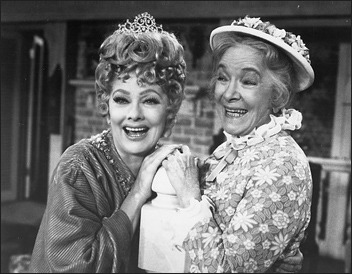
Lucille Ball later said of Hayes:
"I can recommend a performance in company with Helen for giving any actress a true perspective of things. If that experience doesn't give you a sense of humility, nothing will. I found myself devoting as much attention to watching her perform as to actually performing with her. She set the standard for the rest of us."

Helen Hayes plays Kathleen Brady, which is also the name of the biographer who wrote Lucille: The Life of Lucille Ball, published in 1994 by Billboard Books.

The character Hayes plays here capitalizes on her Oscar-winning role of Ada Quonsett in Airport (1970), a sweet little old lady who cons the airlines and stows away to get free air travel. On “Here's Lucy” the plot relies on the premise that Mrs. Brady could be a con artist.

Mrs. Brady receives 'messages' from her late husband Michael from her guides in the spirit world, Napoleon and Josephine Bonaparte. Napoleon Bonaparte (1769-1821) was a French statesman and military leader who rose to prominence during the French Revolution and led several successful campaigns during the French Revolutionary Wars. He was Emperor of the French from 1804 until 1814, and again briefly in 1815. Joséphine de Beauharnais (1763–1814) was the first wife of Napoleon and thus the first Empress of the French.

Harry theorizes that Mrs. Brady may be like the sweet little old ladies in Arsenic and Old Lace, poisoning people with elderberry wine. That is the cue for Mrs. Brady to serve Harry a glass of her late husband's favorite drink – elderberry wine! Lucie Arnaz ad libs the line “That was just a play!” Arsenic and Old Lace by Joseph Kesselring opened on Broadway in 1939 and ran until 1944, during which time Helen Hayes starred in four other Broadway plays. It was made into a film by Frank Capra in 1944. In 1969, Helen Hayes starred in a TV version with Lillian Gish (inset photo), Bob Crane, Fred Gwynne, and David Wayne. The play / film was previously mentioned was in “Lucy and the Ex-Con” (S1;E15).

When Mrs. Brady comes to Harry for financial advice, he brags that “Dun and Bradstreet don't make a move without me!” Dun and Bradstreet is a financial analytics firm founded in 1841 in New York City. They are still in business today, headquartered in Short Hills, New Jersey.

Mrs. Brady has some property she needs to sell located on the northeast corner of Molby and Delaney Streets, in Dublin, Ireland. The Irish consulate tells Harry it is worth $25,000. Harry manages to get Mrs. Brady to part with it for $5,000.
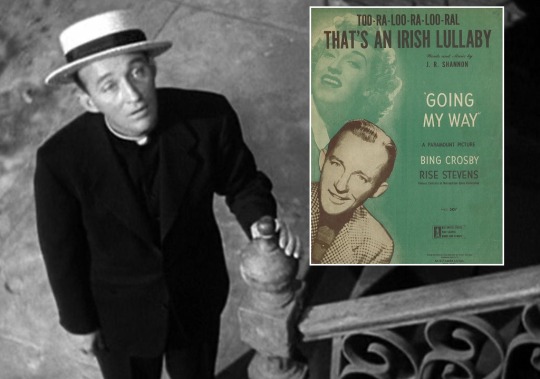
When Harry sees the opportunity to cash in on Mrs. Brady's Dublin property, he sings a bit of "Too-Ra-Loo-Ra-Loo-Ral (That's an Irish Lullaby)" a classic Irish-American song originally written in 1913 by composer James Royce Shannon for the Tin Pan Alley musical Shameen Dhu. The song was brought back to prominence by Bing Crosby in 1944's Going My Way. Crosby's single sold over a million copies and peaked at #4 on the Billboard charts.

When Harry hears Lucy and Kim's scheme about the fake séance, he says “If this is the ship of fools, would you let me off at Catalina?” Ship of Fools was an Oscar-winning film released in 1965 based on the 1962 novel of the same name by Katherine Anne Porter. Catalina, an island off the Los Angeles coast, has been the punchline of many jokes on “Here's Lucy.”

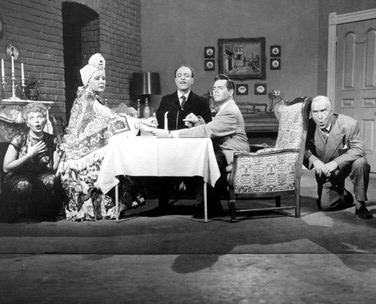
In “The Seance” (ILL S1;E7) the Ricardos and the Mertzes fake a seance to conjure up Tilly for Mr. Merriweather (Jay Novello) in order to further Ricky's career.

Lucille Ball has played stereotypical 'little old ladies' many times. Lucy Carter went gray in “Lucy and the Ex-Con” (S1;E15) and in “Lucy and the Celebrities” (S4;E10, above).

Lucy Carmichael aged herself for “Lucy Helps the Countess” (TLS S4;E8), “Lucy and the Soap Opera” (TLS S4;E19) and “Little Old Lucy” (TLS S6;E7).
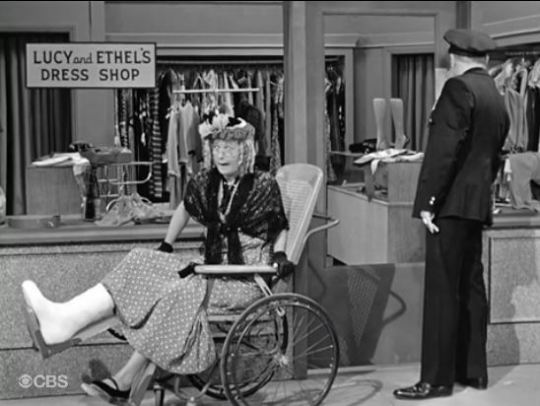
Lucy Ricardo donned old age make-up in “The Young Fans” (ILL S1;E20) and in “The Girls Go Into Business” (ILL S3;E2, above).
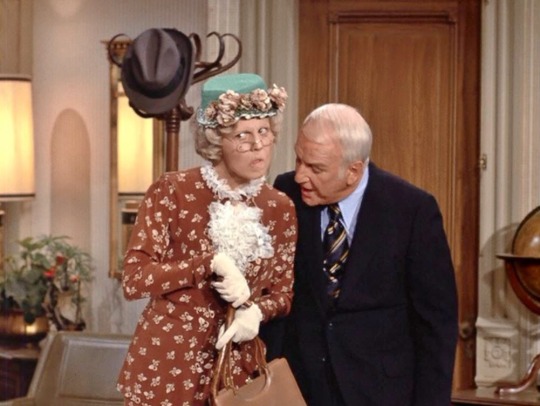
Kim Carter (Lucie Arnaz) took a page from her mother’s playbook and donned the Little Old Lady garb in “Meanwhile, Back at the Office” (S6;E16).
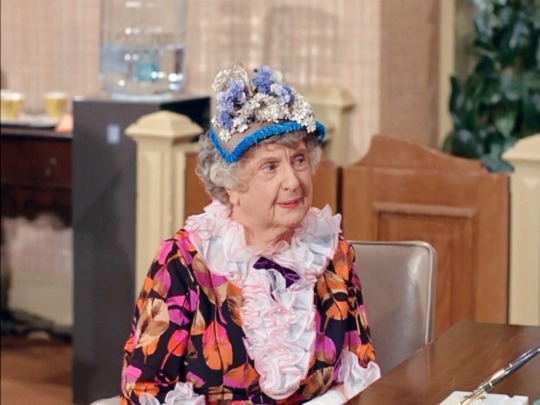
Elderly character actress Ruth McDevitt played an (even more) eccentric little old lady in “Lucy and the Diamond Cutter” (S3;E10). McDevitt may have been considered for the role of Mrs. Brady, but during her episode there was an incident on set that resulted in McDevitt having to receive medical care.

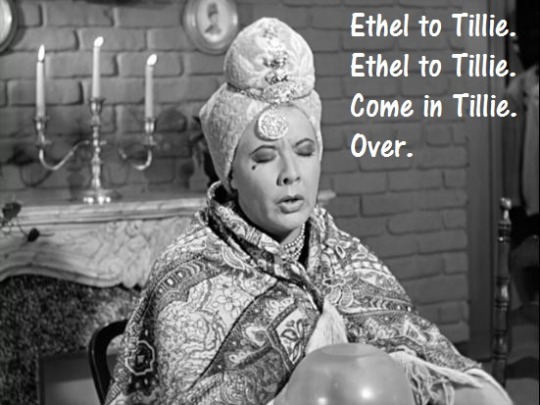
Sitcom Logic Alert! Unlike the classic ‘Ethel to Tilly’ séance on “I Love Lucy” this séance seems a bit overly elaborate for a home-spun spirit raising. It includes
pre-fabricated dummies for Lucy and Harry;
a quick change with elaborate costumes for Harry and Lucy to play Napoleon and Josephine;
a theatrical spotlight in the living room to heighten the drama;
a huge dining room table that appears just for this episode;
three background performers (“Kim's friends”) to fill out the party.
Lucy and Harry do not disguise their voices (which Lucy Ricardo and Fred Mertz did so memorably on “I Love Lucy”) and Lucy's bright red hair (that Mrs. Brady previously remarked on) is not wigged. In short, Mrs. Brady would have to be a real con artist or in the throes of dementia to think the séance was real! But that's the show biz!

“Lucy and the Little Old Lady” rates 4 Paper Hearts out of 5
The Queen of Comedy meets the First Lady of the American Theatre in a memorable episode. Hayes looks to be having a wonderful time in the role and it is a joy to watch.
#Here's Lucy#Lucille Ball#Helen Hayes#Little Old Lady#Lucie Arnaz#gale gordon#Coby Ruskin#Fred S. Fox#Seaman Jacobs#Hank Brandt#Sid Gould#Seance#Napoleon#Josephine Bonaparte#Irish#Arsenic and Old Lace#Airport#Going My Way#Ship of Fools#Catalina#Dun and Bradstreet#CBS#TV#1972
1 note
·
View note
Text
Age of Heroes - Part 3
March 1976
First Contact – Densho at Del Mar, California.
More metahumans emerge.
March 1, 1976:
Jenna Langley, having spent most of the past month at her friend, Marina Neverton’s bedside, suddenly experiences precognitive visions of Marina defending the town (Winchester) against some threat...
The Australian Army secures a meteor from the Lamington National Park.
March 2, 1976
Vanderbilt decides to cooperate with the police when it comes to fighting crime.
It is estimated that there are 50 metahumans in Wellington, New Zealand.
March 3, 1976
Vanderbilt discovers that she can also phase others through walls (as long as she's holding onto them).
A 'Speedster' is reported in Jakarta, Indonesia.
March 4, 1976
Vanderbilt takes the alias of 'Phase Lady'.
More meteorites are found at Salamander Bay.
March 5, 1976
Some meteoric material washes up on Coogee Beach (to the south of Bondi), Sydney...
Phase Lady rescues a family from a house fire (by going through the walls.)
(Of course, the heat would still afffect her).
March 6, 1976
A second meteor is found of the grounds of the University of New England (in the duck pond near Mary White College...)
A meta detective agency is formed in Sydney.
March 7, 1976
A second meteor is found in the Warrumbungles ranges, near the Grand High Tops.
Zara is seen in Coffs Harbour...
March 8, 1976
In a report delivered to Muldoon, there are over 1000 reported metahumans in New Zealand.
March 9, 1976
Alexandra Murray is jailed for arson...
A meteor is found on the grounds of the University of New South Wales.
March 10, 1976
Muldoon announces to the Cabinet that an agency should be set up to monitor metahuman activity in New Zealand.
The Australian Army secures a meteor impact site near the town of Kununurra.
March 11, 1976
A meta-Sea Urchin is reported on the Great Barrier Reef.
March 12, 1976
Meteors are discovered at Anna Bay, New South Wales...
March 13, 1976
More meteors are discovered at Salamander Bay...
March 14, 1976
A meteor is found on the grounds of the Australian National University.
March 18, 1976:
Alien "Densho" falls to earth at Del Mar, California, to emerge as one of the top heroes of all time,...
March 19, 1976
A meta sting ray is found near Townsville, Queensland.
March 20, 1976
Another meta-emergence incident occurs on a Concorde as it approaches London.
March 21, 1976
In Manchester, England, a teenaged 'hero' stops a thief after he absconds from a store...
March 22, 1976
Some meteoric material washes up on Collaroy Beach (at a northern suburb of Sydney), New South Wales.
A meta tunicate is found near Cairns, Queensland.
March 23, 1976
More meteoric material washes up on Bondi beach. It is secured by the Army later in the day.
March 24, 1976
A third meteor is found on the grounds of the University of New England. (Contrary to later reports, it had actually caused minor damage to the Boiler House...)
March 25, 1976
Phase Lady prevents a bank robbery.
March 26, 1976
Phase Lady rescues a few people from a hostage situation.
March 27, 1976
Jenna Langley (while at Marina's bedside) has another series of visions. (Seeing people with powers being killed by flying robots the size of sparrows...)
March 28, 1976
In Blackpool, Lara Rawson, a teenager, finds that she can float in mid air...
March 29, 1976
A meta-squid is found near the Whitsunday Islands, Queensland.
Some meteoric material washes up in the blowhole in Kiama, New South Wales...
March 30, 1976
A hive of meta-bees is discovered on the outskirts of Winchester, MA...
March 31, 1976
Murray is found not guilty of arson...
April 1976
More changes occur, as some metahumans manifest precognitive abilities.
April 1, 1976
Phase Lady investigates a situation that seems strange, but turns out to be an April fools...
April 2, 1976
Some meteoric material washes up on a beach at Coffs Harbour, New South Wales.
April 3, 1976
Some meteoric material washes up on a beach at Byron Bay, New South Wales.
April 4, 1976
A meteor is found to the east of Armidale, near the village of Ebor.
April 5, 1976
In Sheffield, England, a teenaged 'hero' stops a thief after he absconds from a store...
April 6, 1976
Densho meets President Ford in the White House, saying that he will cooperate with the American authorities while on American soil...
April 7, 1976
Meteors are discovered near the Menindee Lakes, in far western New South Wales.
April 8, 1976
Densho returns to Del Mar, California, and establishes the Del Mar Academy, for meta-humans to realise their potential.
April 9, 1976
Another meteor is discovered in bushland near Anna Bay.
April 10, 1976
Meta dragonflies are discovered in Hyde Park, Sydney.
April 11, 1976
Some meteoric material washes up on Cronulla beach (southern Sydney)...
April 12, 1976
Rawson begins to fight crime as Rawfloat...
April 13, 1976
A third meta tunicate is found in the Great Barrier Reef.
April 16, 1976:
New York City, New York. Under Mayor declares bankruptcy under Mayor Abraham Beame, sparking civil unrest and riots,...
April 17, 1976:
Concerned about Jenna’s visions, her parents decide to move away from Winchester.
April 18, 1976
A meta snail is found in a garden in on the outskirts of Paris...
April 19, 1976
Phase Lady defends a house from a group of meta snakes...
April 20, 1976
Henry Rock, a young boy from a small town in Pennsylvania, is taken from his home while reporting massive pain. A few hours later, to the shock of his doctors, he transforms into a young girl. "Henrietta" is smaller in size and with longer hair than Henry but reports comfort with her new body.
April 21, 1976
Meteors are found near Marree, South Australia...
April 25, 1976
There are now 1500 reported metahumans in New Zealand.
0 notes
